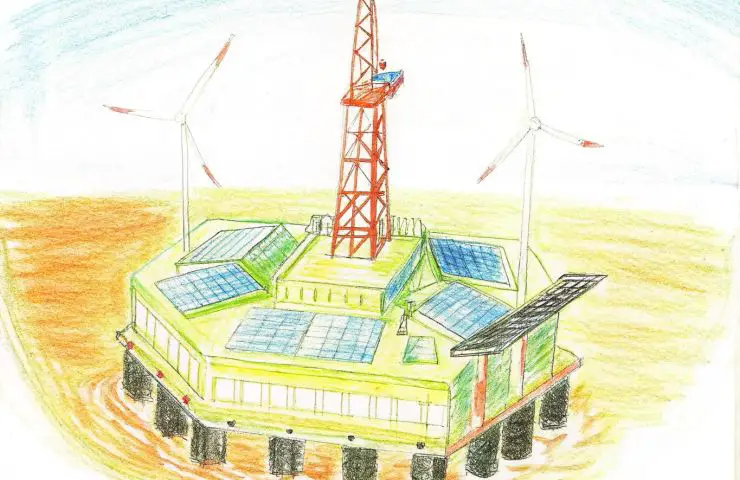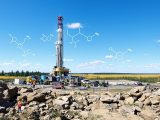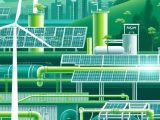
China’s First Offshore Hydrogen–Ammonia–Methanol Platform Yields Green Methanol
October 30, 2025Picture this: a gigantic, 50-plus-meter-tall marvel bobbing off Yantai in the Bohai Sea, powered solely by wind and sun. In October 2025, that dream became reality when China’s first fully integrated offshore hydrogen production–ammonia–methanol platform, led by National Energy Group Hydrogen Energy Technology Co., Ltd. alongside Yantai CIMC Raffles Offshore Engineering Co., Ltd. and Guoneng Hydrogen Innovation Technology (Beijing) Co., Ltd., churned out its inaugural batch of green methanol. This 20,000-ton semi-submersible powerhouse loops renewables, seawater, CO₂, and high-tech chemistry into an entirely off-grid symphony.
An Offshore Powerhouse
It’s decked out with 5 MW of sleek photovoltaic panels, a fleet of wind turbines, and robust battery banks that smooth out the intermittency so operations never skip a beat. A built-in desalination unit cranks out 5 tonnes of freshwater daily—enough for the crew and two separate electrolysis streams. Between direct seawater electrolysis and freshwater PEM/alkaline modules, the platform can produce up to 5 tonnes of green hydrogen each day at roughly 75% efficiency. That hydrogen then feeds two synthesis lines: one crafting ammonia, the other driving a skid-mounted methanol reactor by Shanghai Electric Group Guokong Universal Engineering Co., Ltd., nailing over 80% CO₂ conversion in a single 6.9 MPaG pass.
Pushing Electrolysis to Sea
The real breakthrough? Skipping land-based desalination entirely. Thanks to advanced pretreatment, direct seawater electrolysis—a joint effort between Guoneng Hydrogen Innovation Technology and East China University of Science and Technology—simplifies the feedstock, while a 1 MW backup generator from Weichai guarantees zero downtime on calm or cloudy days. Every module wears a marine-grade coat of armor by Yantai CIMC Raffles, ready to brave salt spray, waves, and storms.
Riding the Blue Economy Wave
Yantai, a city of 7 million historically built on shipyards and heavy industry, has been rewiring its future since 2020—leaning into wind, solar, and marine renewables under the province’s green incentives that mirror China’s 14th Five-Year Plan. Bohai Sea test sites now host dozens of offshore turbines, and this floating hydrogen platform is the next bold step in the region’s push to lead the emerging “blue economy.”
Why It Matters
Traditional renewables hit roadblocks like grid constraints and sky-high transport costs. By moving hydrogen production and e-fuel synthesis offshore, this project sidesteps both. Developers estimate it will slash 36,000 tonnes of CO₂ annually—equivalent to planting 2 million trees—and fuel a 10,000-ton vessel for up to ten days straight. It’s a real game-changer for maritime industrial decarbonization and high-value feedstocks alike.
Setting the Stage for Clean Ammonia
Alongside methanol, the platform co-produces clean ammonia in its dedicated synthesis module. Ammonia’s storage ease and existing shipping network make it a perfect hydrogen carrier. By proving an end-to-end offshore chain—from seawater to liquefied ammonia—this demo sets the course for decarbonized shipping routes and green fertilizer production.
Strategic Implications and Global Reach
This isn’t just a tech showcase; it’s a strategic play. National Energy Group’s “three-step” roadmap calls for a 100-ton methanol hub in Yancheng by 2028, scaling up to a 1,000-ton center in the South China Sea after 2030. Nail that, and China could emerge as a major exporter of e-fuels, boosting energy security and redefining benchmarks for sustainable energy and industrial decarbonization.
A Template for Future Offshore Hubs
Regulators are already drafting technical standards inspired by Yantai. Platform design codes, electrolysis safety protocols, and marine permitting guidelines are all under review. Across Asia and Europe, stakeholders are eyeing this blueprint—eager to adapt its lessons for their own waters. A ripple effect in hydrogen infrastructure could spark fresh demand for engineering, manufacturing, and shipping services.
Challenges Ahead
Of course, the costs are steep. Floating chemical plants require massive capital, specialized vessels, and marine engineers fluent in renewable systems. Supply chains for marine-grade electrolysers and high-pressure synthesis skids are still maturing, stretching lead times. Environmental risks—like marine habitat impacts and lifecycle emissions from steel and concrete—need ongoing study. Plus, the fledgling regulatory regime for offshore energy islands is still taking shape. But every pilot faces hurdles, and this one has already surpassed technical milestones few thought possible at sea.
Looking Beyond the Horizon
There’s something electric about a refinery at sea running on nothing but wind and sun. As we chase net-zero targets, tech that transforms stranded offshore renewables into transportable fuels could be pivotal. Expect a dozen more “energy islands” dotting China’s coast by 2035—each a testament to how green hydrogen and e-fuels can revolutionize the global energy landscape.
About the Company
National Energy Group Hydrogen Energy Technology Co., Ltd., a subsidiary of China Energy Investment Corporation, spearheads national hydrogen pilot projects and offshore renewable integrations, partnering with leaders across energy and engineering sectors.



 With over 15 years of reporting hydrogen news, we are your premier source for the latest updates and insights in hydrogen and renewable energy.
With over 15 years of reporting hydrogen news, we are your premier source for the latest updates and insights in hydrogen and renewable energy.